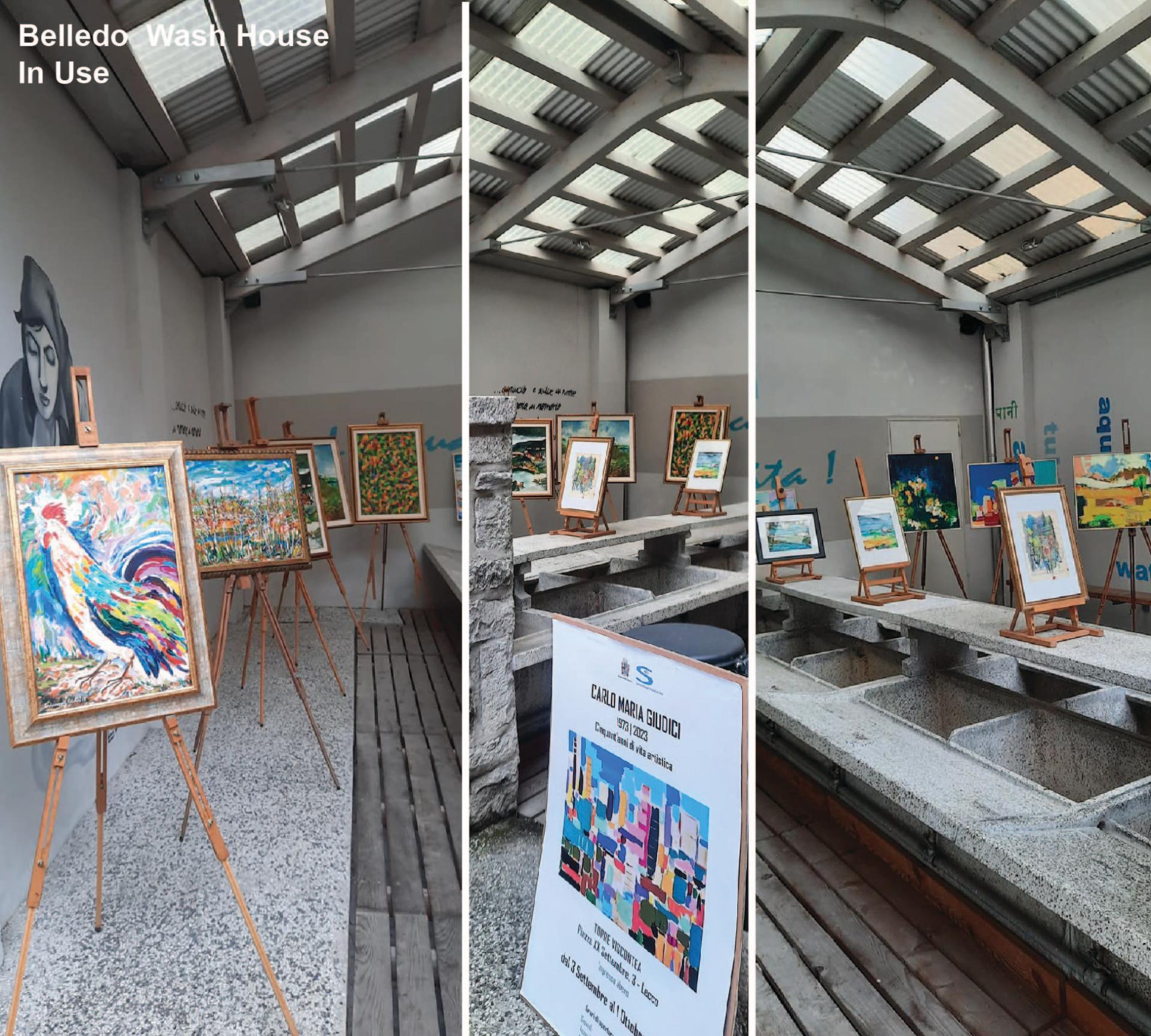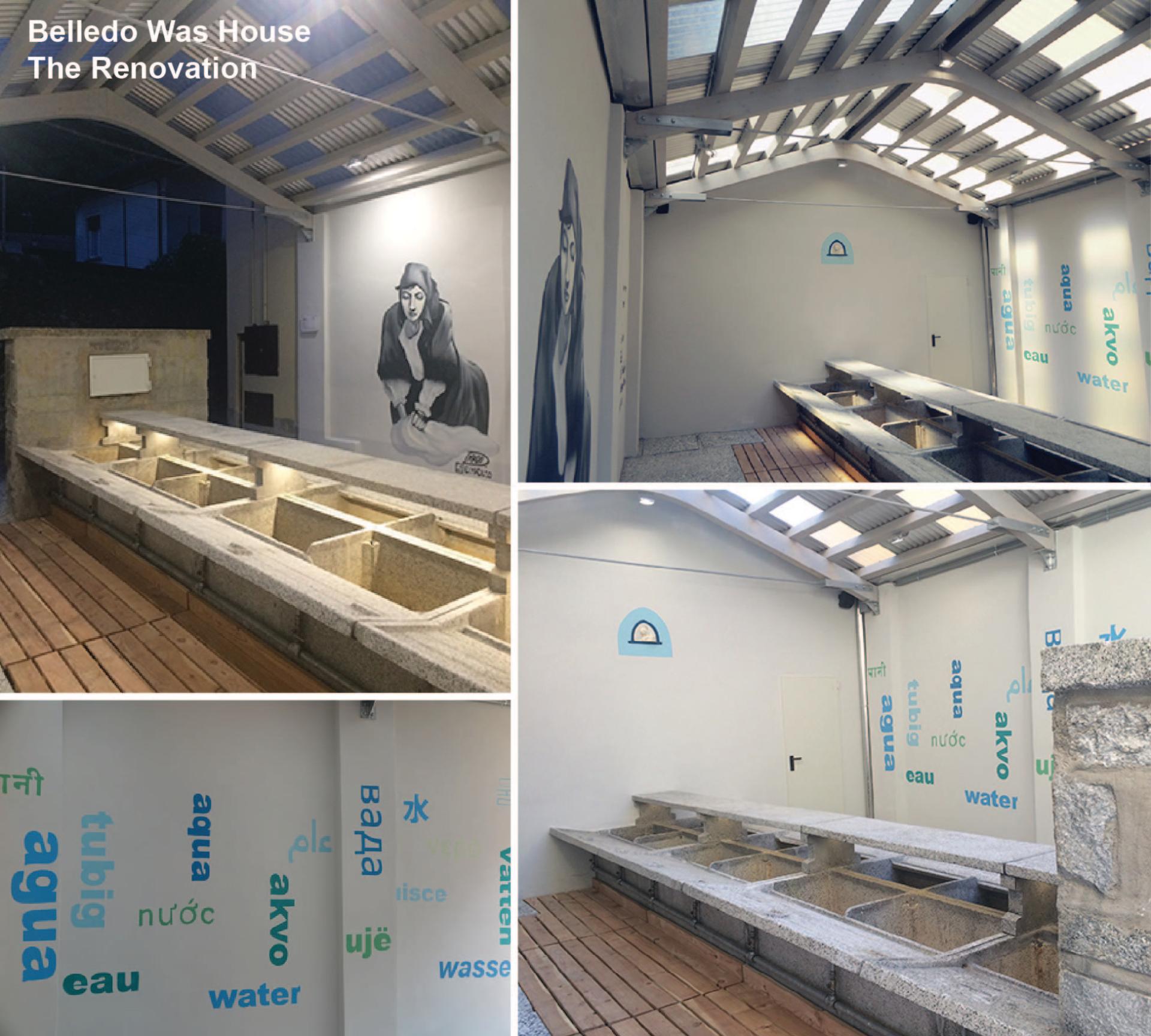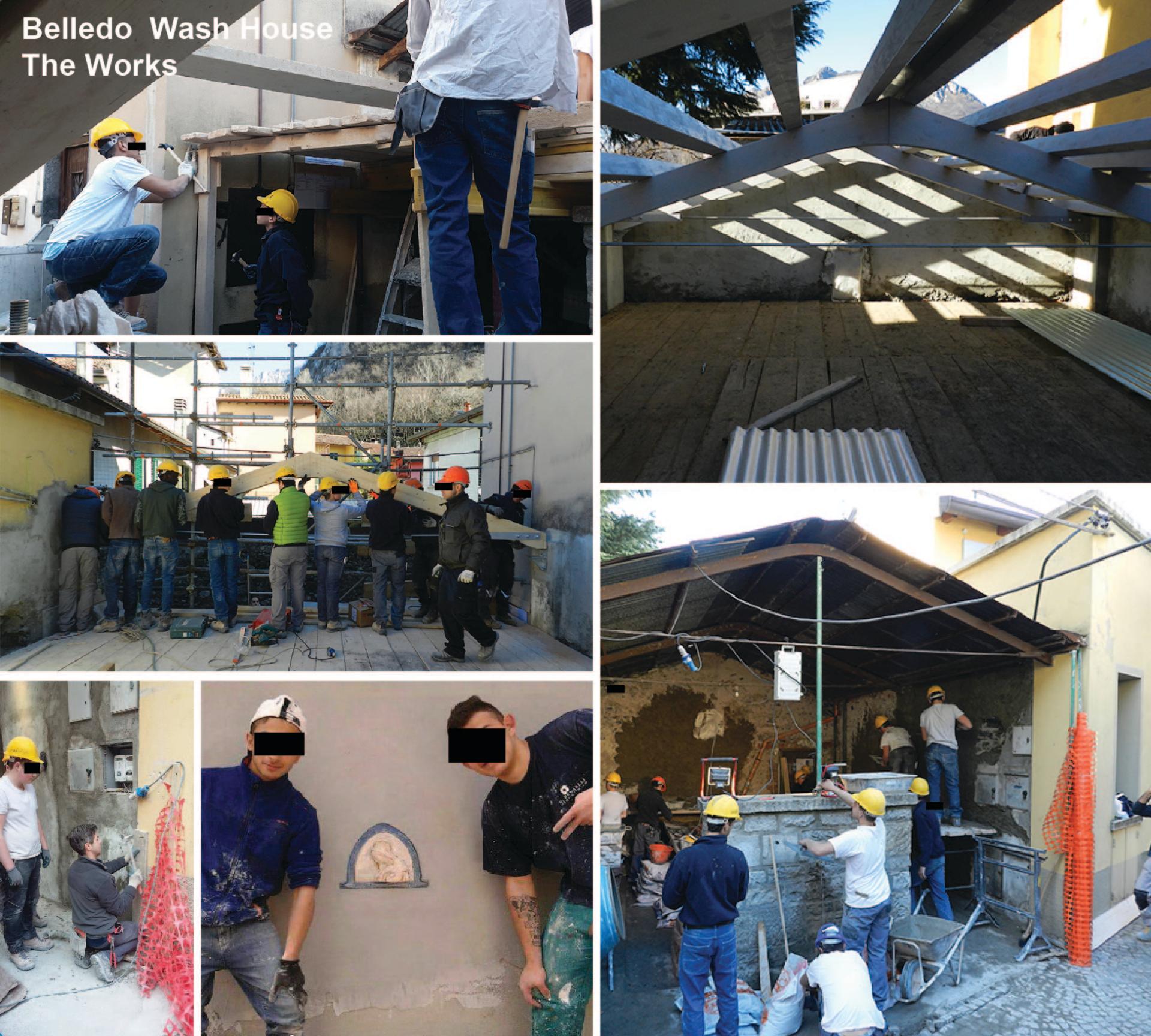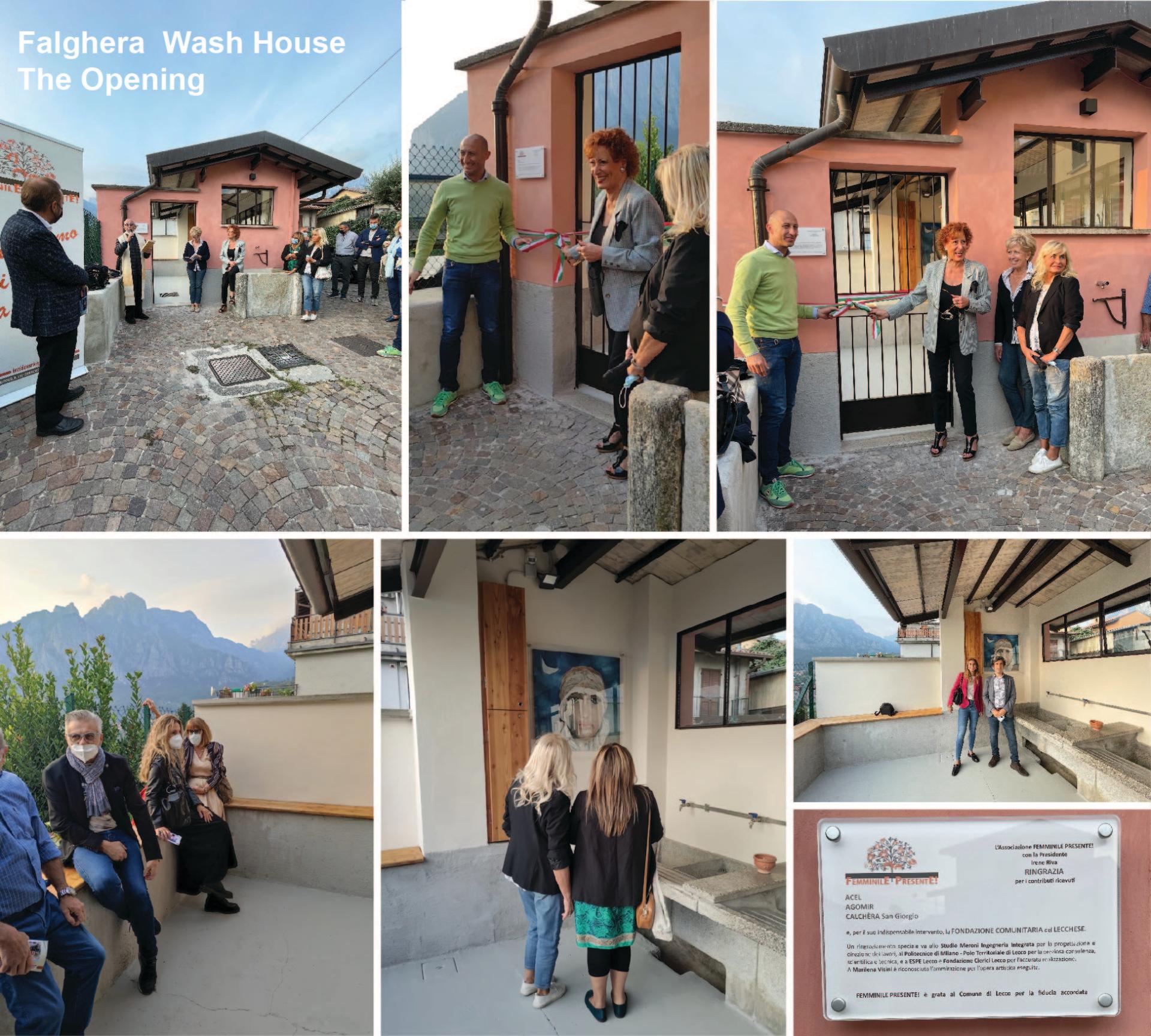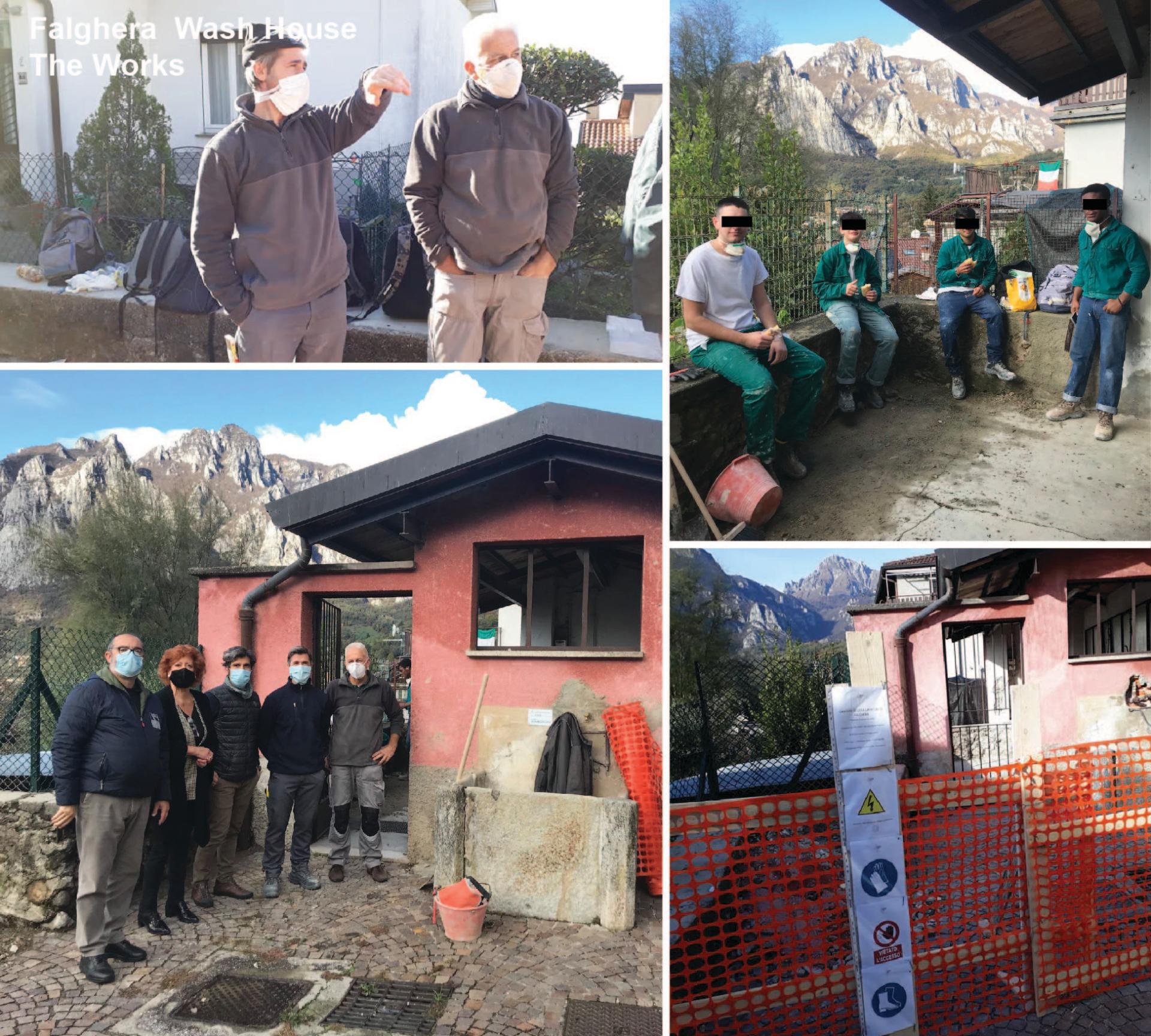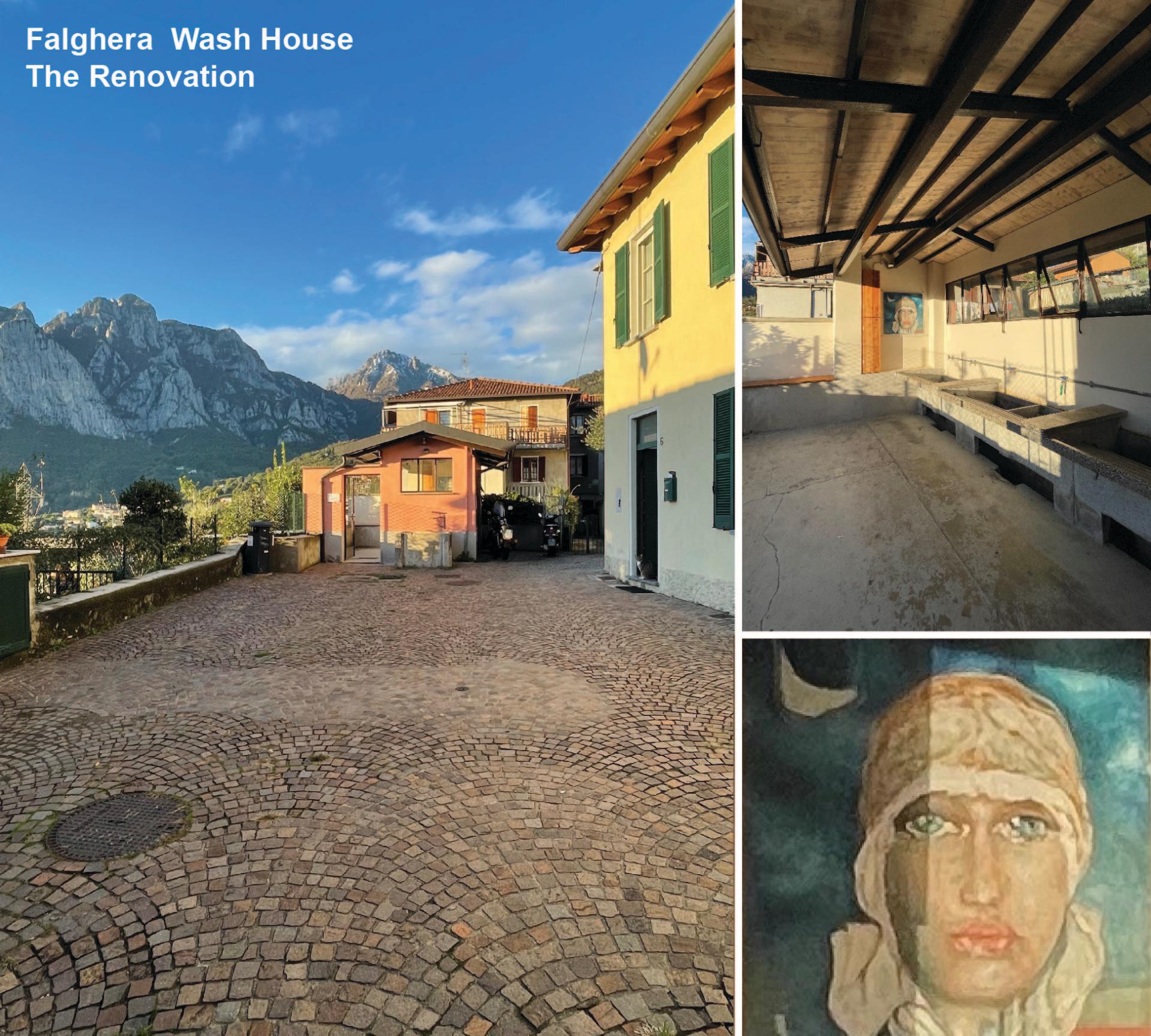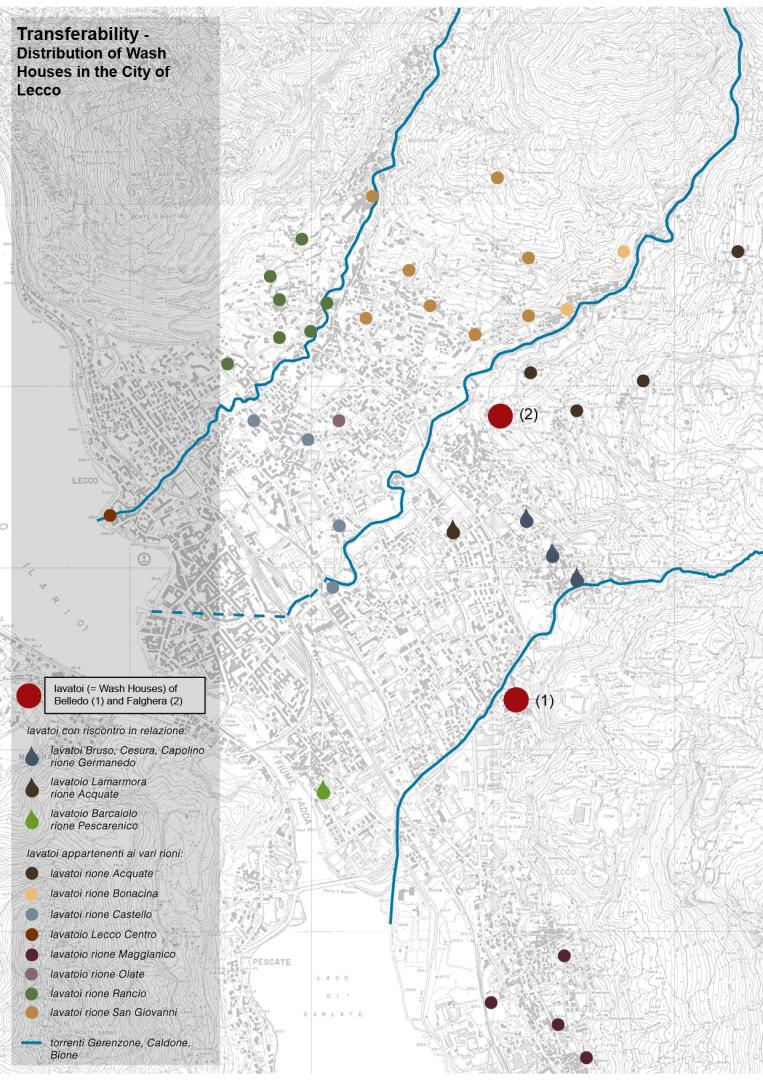R(EU)WASH Houses
Basic information
Project Title
R(EU)WASH Houses
Full project title
REvitalization and rEUse of city’s abandoned WASH Houses through an human-centred-multidisciplinary
Category
Regaining a sense of belonging
Project Description
Neglected and degraded, wash houses were a place to wash laundry, an industrious woman social club, pivotal to community life. Embracing local culture and sustainability, R(EU)WASH House is a multi-disciplinary inter-generational choral effort to revitalize these historical hubs in two “rioni” of the city of Lecco. Embodying the historical charm throw a contemporary art language we offered a refuge to the community to forge new lasting connections and preserve the essence of a shared past.
Geographical Scope
Regional
Project Region
Lombardy (Italy), Italy
Urban or rural issues
Mainly rural
Physical or other transformations
It refers to a physical transformation of the built environment (hard investment)
EU Programme or fund
No
Description of the project
Summary
The city of Lecco, on the east side of lake Como, historically developed around its water bodies, fostering small communities specialized in iron production. Each division had its own essential facility, above which, wash houses, emblematic of community connection and women's societal roles. However, challenged by recent transformations and innovations such as washing machines, the city suburbs are left with neglected and degrading structures, altering traditional urban paradigms and making these spaces obsolete.
Our project embarks on the regeneration of wash houses in Lecco, once a cornerstone for the woman of the neighbourhood, a place to wash laundry, but also an open-air industrious female cultural club. The aim of our idea transcends mere restoration, it aims to revive a connection with local heritage, fostering a communal space for collective engagement and cultural revival.
Spearheaded by the non-profit association "Femminile Present," this endeavour engaged different stakeholders: the community, municipal authorities, a local school, Politecnico of Milan, and regional artists. The collaborative effort ensured inclusivity, harmonizing various perspectives in a regenerative journey expanding beyond the wash houses.
The regenerated spaces in Belledo and Falghera, two suburbs of Lecco, stand as a testament to collective effort, infused with cultural motifs by local artists, blending historical resonance and contemporary art. Sustainability was a core principle, evident in the use of indigenous, locally sourced materials, connecting the building to the region's manufacturing legacy.
The spaces, breathe life into the community, fostering intergenerational exchanges and serving as a cradle for collective endeavours. The project culminates in structures repleted with purpose, identity, beauty, and a renewed sense of belonging, offering the community a refuge to forge new lasting connections and to preserve the essence of their shared past.
Our project embarks on the regeneration of wash houses in Lecco, once a cornerstone for the woman of the neighbourhood, a place to wash laundry, but also an open-air industrious female cultural club. The aim of our idea transcends mere restoration, it aims to revive a connection with local heritage, fostering a communal space for collective engagement and cultural revival.
Spearheaded by the non-profit association "Femminile Present," this endeavour engaged different stakeholders: the community, municipal authorities, a local school, Politecnico of Milan, and regional artists. The collaborative effort ensured inclusivity, harmonizing various perspectives in a regenerative journey expanding beyond the wash houses.
The regenerated spaces in Belledo and Falghera, two suburbs of Lecco, stand as a testament to collective effort, infused with cultural motifs by local artists, blending historical resonance and contemporary art. Sustainability was a core principle, evident in the use of indigenous, locally sourced materials, connecting the building to the region's manufacturing legacy.
The spaces, breathe life into the community, fostering intergenerational exchanges and serving as a cradle for collective endeavours. The project culminates in structures repleted with purpose, identity, beauty, and a renewed sense of belonging, offering the community a refuge to forge new lasting connections and to preserve the essence of their shared past.
Key objectives for sustainability
Our central goal is to restore the local heritage and bonds embodied in the wash houses, historical symbol of the unity and tireless work of the female community. The project's focuses in revitalizing both the physical structures and the communal spirit, fostering a shared purpose through participative design. We aimed to transform these unused and degraded spaces into multifunctional community hubs, and to create inclusive spaces for meetings, cultural events, and open dialogues.
Embracing a participative and intergenerational approach, the project gathered different age groups to collaborate, harmonizing diverse perspectives. From high school to pensioners, this collaborative effort aimed to create a space that belongs to and is wanted by all, instilling a sense of responsibility for the environment, and ensuring sustainable usage for future generations. Choosing renovation over reconstruction preserved the buildings' structural integrity, reducing costs and construction time by maximizing the reuse of existing materials. Volume alterations were minimal, this approach ensured economic sustainability for the local municipality and sponsors. Our commitment to sustainability extended to the integration of locally sourced 'natural' elements, such as pure lime and plaster from food supply waste, and innovative materials like sand derived from eggshells and rice husk ash. When the roof structure substitution was necessary in the wash house of Belledo, the choice was wood beams, aligning the building with sustainability principles and local context. In fact, the province of Lecco is well known for the abundance of sawmills and wood production. The space evolved into a living testament to the village's history, offering a free, approachable, and inclusive environment for all, ensuring economic and social inclusivity.
Embracing a participative and intergenerational approach, the project gathered different age groups to collaborate, harmonizing diverse perspectives. From high school to pensioners, this collaborative effort aimed to create a space that belongs to and is wanted by all, instilling a sense of responsibility for the environment, and ensuring sustainable usage for future generations. Choosing renovation over reconstruction preserved the buildings' structural integrity, reducing costs and construction time by maximizing the reuse of existing materials. Volume alterations were minimal, this approach ensured economic sustainability for the local municipality and sponsors. Our commitment to sustainability extended to the integration of locally sourced 'natural' elements, such as pure lime and plaster from food supply waste, and innovative materials like sand derived from eggshells and rice husk ash. When the roof structure substitution was necessary in the wash house of Belledo, the choice was wood beams, aligning the building with sustainability principles and local context. In fact, the province of Lecco is well known for the abundance of sawmills and wood production. The space evolved into a living testament to the village's history, offering a free, approachable, and inclusive environment for all, ensuring economic and social inclusivity.
Key objectives for aesthetics and quality
Wash houses, once vibrant hubs of community life, have turned into forgotten relics, losing their essence and fading from memory in the rush of modernity. A place of degradation, that the community avoids. Our project, embarked on a journey to resurrect these neglected structures, infusing them with character, artistic legacy, and eventually, significance back.
The approach towards the artistic choices aimed to use art to facilitate the integration of the structure in the local environment. Our objective was to revive the local artistic scene while fostering a deeper connection with the space. We aimed to show that art is not confined to galleries but resides in the streets, waiting to be discovered in the most unexpected corners. Creating a beautiful and welcoming space, to spark the desire for preservation.
In Belledo, the first application, a local street artist created a contemporary composition, a woman engaged in the timeless act of washing clothes, a citation of a famous (local) historical writer, stand next to a wall that shows different translation of the word “water”. In Falghera, the artwork, created by a painter from the Lecco area, places in the middle the woman figure, the strength and the resilience. Here, the wooden benches, offer an occasion to stop and contemplate the beautiful landscape of Como Lake, of the city of Lecco and the surrounding mountains. In both applications, we used natural materials to create a warmer and welcoming environment.
Through the power of art and design, these creations spark conversations, invoke a sense of wonder about the city and local artists, fostering dialogue and reflection within the community, thus rejuvenating the very essence of these forgotten spaces.
The approach towards the artistic choices aimed to use art to facilitate the integration of the structure in the local environment. Our objective was to revive the local artistic scene while fostering a deeper connection with the space. We aimed to show that art is not confined to galleries but resides in the streets, waiting to be discovered in the most unexpected corners. Creating a beautiful and welcoming space, to spark the desire for preservation.
In Belledo, the first application, a local street artist created a contemporary composition, a woman engaged in the timeless act of washing clothes, a citation of a famous (local) historical writer, stand next to a wall that shows different translation of the word “water”. In Falghera, the artwork, created by a painter from the Lecco area, places in the middle the woman figure, the strength and the resilience. Here, the wooden benches, offer an occasion to stop and contemplate the beautiful landscape of Como Lake, of the city of Lecco and the surrounding mountains. In both applications, we used natural materials to create a warmer and welcoming environment.
Through the power of art and design, these creations spark conversations, invoke a sense of wonder about the city and local artists, fostering dialogue and reflection within the community, thus rejuvenating the very essence of these forgotten spaces.
Key objectives for inclusion
Our project champions inclusivity through dialogue-centred design, born from the community's effort to reclaim neglected and degraded parts of the city. The initiative aimed to revive these spaces, recognizing that caring for common areas is equal to nurturing community well-being. Affordability and accessibility for all were at the heart of the initiative. By adopting a participative design approach, the project ensured that the voices and needs of the community were integral to the renovation process. This collaborative engagement empowered locals, inviting them to participate in the repurposing process, thereby fostering a sense of belonging and ownership among the community members. This is also testified by the creation of a local volunteers committee to maintain and manage the space at the end of the intervention. We employed art to promote inclusion. Italy's history has been marked by its multicultural roots, given its strategic Mediterranean location and various dominions. Today, is integrated into Europe and it’s experiencing a migration wave. We aimed to honour diversity and inclusion through the artwork adorning the washhouses, to celebrate a new, enlarged and multi-cultural community.
The spaces offer free drinkable water for everyone, in Belledo, the world “water” translated into different languages is welcoming all the cultures. In Falghera, the painting of a nameless woman, speaks to everyone with empathic blue eyes.
Architecture and art can be strong enablers to strengthen identity. The goal was to create environments infused with cultural resonance and social connectivity, that not only accommodated but celebrated the diversity and needs of all community members, from every age group.
The spaces offer free drinkable water for everyone, in Belledo, the world “water” translated into different languages is welcoming all the cultures. In Falghera, the painting of a nameless woman, speaks to everyone with empathic blue eyes.
Architecture and art can be strong enablers to strengthen identity. The goal was to create environments infused with cultural resonance and social connectivity, that not only accommodated but celebrated the diversity and needs of all community members, from every age group.
Results in relation to category
By involving different generations in the process, the sense of belonging increased, which helped to reduce the degradation and vandalism of the place.
When the first application of the project in Falghera was completed, some neighbourhood organized to create a local “Committee” formed by people of the area, to take care of the place and propose events. Lately (October 2023) a little art exhibition with paintings from a local artist was organized in the wash house of Belledo.
The collection of people’s memories from the washhouse, together with the shared effort to repurpose the area, helped in the appropriation of the washhouses, which is now a beautiful, sustainable and safe meeting space. A place to refresh in summer while climbing up the hill, find shelter during the rainy days and just stop, take a moment to breath and contemplate the beautiful simple pieces of art that make the backstage to the breathtaking views of Como Lake and the surrounding mountains.
This repurposing project embodies a return to the roots, bridging between the historical and contemporary threads of the community's fabric. It embodies a regenerative process that not only restores a sense of belonging but also ignites forward-thinking aspirations for local communities.
It beautifully aligns with the aspirations to connect a future rooted in the heritage area and the vibrancy of its modern cultural and artistic expressions.
When the first application of the project in Falghera was completed, some neighbourhood organized to create a local “Committee” formed by people of the area, to take care of the place and propose events. Lately (October 2023) a little art exhibition with paintings from a local artist was organized in the wash house of Belledo.
The collection of people’s memories from the washhouse, together with the shared effort to repurpose the area, helped in the appropriation of the washhouses, which is now a beautiful, sustainable and safe meeting space. A place to refresh in summer while climbing up the hill, find shelter during the rainy days and just stop, take a moment to breath and contemplate the beautiful simple pieces of art that make the backstage to the breathtaking views of Como Lake and the surrounding mountains.
This repurposing project embodies a return to the roots, bridging between the historical and contemporary threads of the community's fabric. It embodies a regenerative process that not only restores a sense of belonging but also ignites forward-thinking aspirations for local communities.
It beautifully aligns with the aspirations to connect a future rooted in the heritage area and the vibrancy of its modern cultural and artistic expressions.
How Citizens benefit
Vandalism and degradation of public properties evolves from a sense of alienation from spaces; hence the lack of social activities and collective consciousness is the cause and the key for solving it. The participative dialogue-centred design approach is key to regain a sense of belonging by tailoring solutions to meet the specific requirements and nuances of the community in terms of design and space. Involving end-users in the design and execution process, instills a profound sense of ownership within the citizens, empowering them to shape the space they will inhabit. This engagement sparks a deeper connection and satisfaction with the final design, ensuring solutions that are tuned to community wishes. Moreover, it fosters a sense of ownership and empowerment among those who will ultimately use the product or service. Ultimately, it will avoid that the space will be forgot again.
In this sense, the spontaneous creation of a neighbourhood committee to self-govern and monitor the space, is strong evidence of how people started to care about its conservation after participating in the repurposing.
By regaining forgotten areas, citizens are awarded with a renewed gathering space, nurturing a sense of community and belonging. These spaces, born in the suburbs of the city, revive the outskirts of Lecco, sensitizing people towards beauty, and stimulating the need for conservation. Ultimately, this space connected different generational groups, teenagers, with adults and pensioners, equalizing them in the common goal of making the city more beautiful, more sustainable, together.
In this sense, the spontaneous creation of a neighbourhood committee to self-govern and monitor the space, is strong evidence of how people started to care about its conservation after participating in the repurposing.
By regaining forgotten areas, citizens are awarded with a renewed gathering space, nurturing a sense of community and belonging. These spaces, born in the suburbs of the city, revive the outskirts of Lecco, sensitizing people towards beauty, and stimulating the need for conservation. Ultimately, this space connected different generational groups, teenagers, with adults and pensioners, equalizing them in the common goal of making the city more beautiful, more sustainable, together.
Physical or other transformations
It refers to a physical transformation of the built environment (hard investment)
Innovative character
Most of the Italian building stock was built before the ‘90s, hence the field of restoration, is well established both as a practice than in academia. Traditional design approaches often view a building in isolation, following a linear process where an architect conducts a survey, designs the project, and subsequently hands it over to separate entities, each party is involved in a limited role, their engagement concluding upon completion of their task.
Embracing an integrated design process, our approach diverged from this conventional path.
We allowed different stakeholders to influence the design phase, fostering a cooperative process that demanded more time for decisions but yielded enriched outcomes. This method minimized the risk of incompatible solutions, therefore avoiding time and cost inefficiencies.
The dialogue-centred design focused on participation, deviating from traditional practices in Italy norm and Lecco area, engaged various levels and generations. Italy's rich architectural heritage often confines practitioners to a conservative design ethos. Our intent was to challenge these rooted traditions and set a new positive example.
While Italy brags a rich artistic history evident in its numerous historical sites and buildings, wash houses strongly linked to the working or lower classes, remain a silent chapter in this sense.
We tried to enhance the beauty of these historical places, uncovering a hidden side of this spaces, we glorified the element “water” and the humble act of washing clothes, showing how this universal act contains in its simplicity a warm soft beauty that infuses the repurposed spaces, creating an empathic building that rises in the universal language of art.
Embracing an integrated design process, our approach diverged from this conventional path.
We allowed different stakeholders to influence the design phase, fostering a cooperative process that demanded more time for decisions but yielded enriched outcomes. This method minimized the risk of incompatible solutions, therefore avoiding time and cost inefficiencies.
The dialogue-centred design focused on participation, deviating from traditional practices in Italy norm and Lecco area, engaged various levels and generations. Italy's rich architectural heritage often confines practitioners to a conservative design ethos. Our intent was to challenge these rooted traditions and set a new positive example.
While Italy brags a rich artistic history evident in its numerous historical sites and buildings, wash houses strongly linked to the working or lower classes, remain a silent chapter in this sense.
We tried to enhance the beauty of these historical places, uncovering a hidden side of this spaces, we glorified the element “water” and the humble act of washing clothes, showing how this universal act contains in its simplicity a warm soft beauty that infuses the repurposed spaces, creating an empathic building that rises in the universal language of art.
Disciplines/knowledge reflected
Sustainability is at the core of our project proposal. To ensure economic sustainability, we used an integrated project delivery approach that minimizes changes and delays, reducing both material costs and execution time. By using natural materials such as wood beams for Belledo's new roof and plasters made from rice husk in Falghera, we're committed to environmental sustainability. Additionally, our participative methodology ensures social inclusivity in the resulting buildings. The volunteering association, the catalyst for change, raised an urban issue of sociological significance, driving us to challenge outdated social paradigms that lowered the community's bond with its surroundings. The building itself became a unifying force, binding stakeholders in a collective expression of engagement and commitment. Within academia, a mix of technical expertise harmonized different technical subjects. Civil engineering in the audit of the roof and structures integrity, architecture, while performing an architectural survey into the building's environmental impact. Material science, in collaboration with local contractors, seeking sustainable materials locally produced to reduce the structure's ecological footprint. The secondary school's craftsmanship seamlessly mingled with this group. Moreover, our design fuses art and poetry through a permanent installation, a narrative that connects different stakeholders with the rich history of our city.
The volunteering group's past experiences in civic initiatives, was the glue that linked the different parties, infusing the project with passion, nurturing a collaborative spirit, and fostering connections with economic sponsors. Academia, as the bridge, facilitated connections with technical sponsors while involving the secondary school in this creative collaboration. This amalgamation of disciplines and perspectives forms the essence of our project, resonating with a collective commitment to sustainable societal reformation.
The volunteering group's past experiences in civic initiatives, was the glue that linked the different parties, infusing the project with passion, nurturing a collaborative spirit, and fostering connections with economic sponsors. Academia, as the bridge, facilitated connections with technical sponsors while involving the secondary school in this creative collaboration. This amalgamation of disciplines and perspectives forms the essence of our project, resonating with a collective commitment to sustainable societal reformation.
Methodology used
This journey began with a deep reflection on Lecco’s landscape, recognizing the great number of abandoned spaces that affects the area's integrity, whereas representing an immense untapped potential. These neglected spaces not only erode the visual appeal but contribute to disconnect the community from the place, who would avoid and eventually erase them from its memory.
Driven to alter this narrative, our focus wasn't solely on restoration but also on initiating a deeper process of repurposing, through an inclusive dialogue with the community.
We wanted to ensure the project's endurance, fostering a bond between the space and its users. Essential to this was involving diverse generations, reviving these areas into free, communal spaces, thanks to a collective dialogue.
We honoured the industrious and social side of the traditional wash houses by addopting a transgenerational participatory approach. In line with this concept, we invited various age groups to actively shape these spaces, fostering a sense of collective pride and shared accomplishment.
With numerous unused spaces, and the idea to reuse the scheme in the future, cost-efficiency was paramount. We minimized new materials, using new resources only if strictly needed, e.g. to ensure the roof stability in Belledo. Concurrently, our commitment to boost regional pride led to collaborations with local artists and regional material producers, emphasizing sustainable, natural products.
The objective was to counter past degradation by transforming these spaces into beautiful, safe and healthy environments, driving a rebirth of vitality.
This harmonious fusion of environmental mindfulness, local craftsmanship, and community engagement laid the groundwork for the space's revival, associating a narrative of renewal and communal reclamation within Lecco's urban fabric.
Driven to alter this narrative, our focus wasn't solely on restoration but also on initiating a deeper process of repurposing, through an inclusive dialogue with the community.
We wanted to ensure the project's endurance, fostering a bond between the space and its users. Essential to this was involving diverse generations, reviving these areas into free, communal spaces, thanks to a collective dialogue.
We honoured the industrious and social side of the traditional wash houses by addopting a transgenerational participatory approach. In line with this concept, we invited various age groups to actively shape these spaces, fostering a sense of collective pride and shared accomplishment.
With numerous unused spaces, and the idea to reuse the scheme in the future, cost-efficiency was paramount. We minimized new materials, using new resources only if strictly needed, e.g. to ensure the roof stability in Belledo. Concurrently, our commitment to boost regional pride led to collaborations with local artists and regional material producers, emphasizing sustainable, natural products.
The objective was to counter past degradation by transforming these spaces into beautiful, safe and healthy environments, driving a rebirth of vitality.
This harmonious fusion of environmental mindfulness, local craftsmanship, and community engagement laid the groundwork for the space's revival, associating a narrative of renewal and communal reclamation within Lecco's urban fabric.
How stakeholders are engaged
The project exemplifies a collective endeavour where various stakeholders harmoniously merged their expertise. Diverse entities played a role, each contributing a unique thread in the fabric of transformation:
-The Volunteer group ”Femminile Presente” of Lecco was the force that started and orchestrated the initiative. This volunteering group touched base with the different stakeholders, nurturing essential connections with both economic and technical sponsors.
-University “Politecnico di Milano” cooperated with the students from the department of Building Engineering and Architecture. Their engagement spanned from crafting the preliminary design to engaging in various facets of the project execution. The approach endorsed the use of innovative natural based plasters and natural design elements, turned the construction site into a living laboratory, showing the positive cooperation of academia and real-world application.
-The secondary school took care of the realization of the renovation strategies in the form of a stage for the students. They organized the construction site in its organisational, technical and safety requirements, creating a dynamic partnership between education and tangible implementation.
- The Municipality of Lecco granted a pivotal endorsement, emphasizing the communal backing for this initiative, while the economical & technical sponsors, financed part of the project and provided the materials.
The multi-level engagement and intergenerational collaboration was both horizontal, each of the above-mentioned parties organized sub-working groups, and vertical, as there was a strong cooperation and interaction between all the different levels of the organization, creating strong network also for future endeavours. The collective efforts of the different stakeholders embodied the spirit of interdisciplinary showcased how diverse entities can create positive and enriching synergies.
-The Volunteer group ”Femminile Presente” of Lecco was the force that started and orchestrated the initiative. This volunteering group touched base with the different stakeholders, nurturing essential connections with both economic and technical sponsors.
-University “Politecnico di Milano” cooperated with the students from the department of Building Engineering and Architecture. Their engagement spanned from crafting the preliminary design to engaging in various facets of the project execution. The approach endorsed the use of innovative natural based plasters and natural design elements, turned the construction site into a living laboratory, showing the positive cooperation of academia and real-world application.
-The secondary school took care of the realization of the renovation strategies in the form of a stage for the students. They organized the construction site in its organisational, technical and safety requirements, creating a dynamic partnership between education and tangible implementation.
- The Municipality of Lecco granted a pivotal endorsement, emphasizing the communal backing for this initiative, while the economical & technical sponsors, financed part of the project and provided the materials.
The multi-level engagement and intergenerational collaboration was both horizontal, each of the above-mentioned parties organized sub-working groups, and vertical, as there was a strong cooperation and interaction between all the different levels of the organization, creating strong network also for future endeavours. The collective efforts of the different stakeholders embodied the spirit of interdisciplinary showcased how diverse entities can create positive and enriching synergies.
Global challenges
Our initiative focuses on preserving cultural heritage while trying to promote socio-economic transformation with the final aim to contribute to inclusion and growth in the neighbourhood. This is done by gifting the neighbourhood with a free community space, that offers a gathering space for people of every generation.
Our design speaks a universal artistic language. We aimed to craft a solution that not only renovates but reimagines spaces, demonstrating how repurposing and renovation can align with sustainability principles. Embracing eco-friendly materials and design practices, our project showcases the shift towards a sustainable construction sector, breaking away from old, polluting techniques.
The UN's Sustainable Development Goals (SDGs) provide a compass for our aspirations. Our project directly addresses several SDGs:
-SDG 6: Italy, like much of Mediterranean Europe, struggles with drought, impacting the Alpine range and water sources. Our initiative, with its innovative approach, addresses this challenge by providing accessible clean water, turning wash houses into refreshing points during hot, dry summers and ensuring a sustainable water supply.
-SDG 11, Our design spearheads the journey toward sustainable, clean, and healthy cities, setting a precedent for urban development that prioritizes ecological harmony.
-SDG 16 Our project champions inclusivity by creating a communal space that welcomes all, fostering a sense of unity and belonging within the neighbourhood.
Embodying the spirit of the New European Bauhaus, our project stands as a guide for change, blending heritage preservation with socio-economic progress, while championing sustainability, inclusivity, and community well-being.
Our design speaks a universal artistic language. We aimed to craft a solution that not only renovates but reimagines spaces, demonstrating how repurposing and renovation can align with sustainability principles. Embracing eco-friendly materials and design practices, our project showcases the shift towards a sustainable construction sector, breaking away from old, polluting techniques.
The UN's Sustainable Development Goals (SDGs) provide a compass for our aspirations. Our project directly addresses several SDGs:
-SDG 6: Italy, like much of Mediterranean Europe, struggles with drought, impacting the Alpine range and water sources. Our initiative, with its innovative approach, addresses this challenge by providing accessible clean water, turning wash houses into refreshing points during hot, dry summers and ensuring a sustainable water supply.
-SDG 11, Our design spearheads the journey toward sustainable, clean, and healthy cities, setting a precedent for urban development that prioritizes ecological harmony.
-SDG 16 Our project champions inclusivity by creating a communal space that welcomes all, fostering a sense of unity and belonging within the neighbourhood.
Embodying the spirit of the New European Bauhaus, our project stands as a guide for change, blending heritage preservation with socio-economic progress, while championing sustainability, inclusivity, and community well-being.
Learning transferred to other parties
Considering the aged Italian building stock and its need for refurbishment, we focused in creating a method for repurposing and facilitating multi-level engagement applicable to different public facilities across Italy.
The transferrable methodology has some core aspects:
-Multi-generation participatory process to stimulate a deeper sense of connection and pride in these spaces in every age group
- Volunteering association leadership - that works on the territory, patronizing the sustainability principle and becoming the driving force behind a quest for an improved, more liveable environment without materialistic inclinations.
- Educational Institutions Engagement: Collaborations with local high schools are vital in sparking creativity and fostering a sense of connection with generations that will grow in the neighbourhood with these spaces. Partnerships with universities and research institutes contribute innovative research methodologies to our approach.
- (Local) Artists Collaborations: engaging with local painters and street artists signifies the project's artistic appeal, with an open view on diverse creative influences
- Eco-Conscious Design with Cost Efficiency: Prioritizing renovation over reconstruction, minimizing new material usage, and consistently selecting sustainable, healthy, (preferably) locally sourced materials to infuse an eco-friendly essence into the spaces.
- Tailored design, as no space is equal, no repurposing can be the same
The transferrable methodology has some core aspects:
-Multi-generation participatory process to stimulate a deeper sense of connection and pride in these spaces in every age group
- Volunteering association leadership - that works on the territory, patronizing the sustainability principle and becoming the driving force behind a quest for an improved, more liveable environment without materialistic inclinations.
- Educational Institutions Engagement: Collaborations with local high schools are vital in sparking creativity and fostering a sense of connection with generations that will grow in the neighbourhood with these spaces. Partnerships with universities and research institutes contribute innovative research methodologies to our approach.
- (Local) Artists Collaborations: engaging with local painters and street artists signifies the project's artistic appeal, with an open view on diverse creative influences
- Eco-Conscious Design with Cost Efficiency: Prioritizing renovation over reconstruction, minimizing new material usage, and consistently selecting sustainable, healthy, (preferably) locally sourced materials to infuse an eco-friendly essence into the spaces.
- Tailored design, as no space is equal, no repurposing can be the same
Keywords
Washhouse
Reuse
Reconnection
Intergenerational engagement
Participative design

